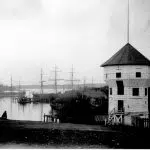
Remote Labrador location potential training ground for astronauts
When scientists determined in the mid-1970s that the Mistastin crater in Labrador had lunar-like properties, the last Apollo mission had flown and it was too late for astronauts to take advantage of the site for training.
But now, as Artemis astronauts prepare for the next moon mission, one Canadian expert says the remote crater could provide vital insight into what awaits them.
Gordon Osinski, a professor in the department of Earth sciences at Western University in London, Ont., said Mistastin was found to be an impact crater in the mid-1970s.
An impact crater is created when an asteroid or meteorite crashes into the Earth, melting and recrystallizing rock through shock waves. One of the unique things about Mistastin, he said, is that it is formed from anorthosite — a light-coloured, highly reflective stone — that makes up large parts of the moon’s surface called lunar highlands.


